Was the Korean War worth the cost?
Several factors contributed to the Korean Conflict being called America's "Forgotten War." It never unified the country in its support the way World War II did. Americans were not asked to sacrifice through rationing and other programs. In World War II, defeat of Nazi Germany and Japan was the obvious goal. Korea was part of the Cold War global struggle against communism, but the United States was not directly fighting either the Soviet Union or China, its major proponents. American war aims in the Korean Conflict were not as clear. And the war never really ended. Neither side surrendered. A negotiated armistice established the 38th parallel as the dividing line between the two Koreas, just as it had been before the fighting commenced. The Korean peninsula was devastated. Was the cost of the war worth it?
Clash with Communists
The Korean peninsula off the east cost of Asia has had a long history of foreign invaders. In 1910, Japanese armies conquered Korea and occupied it until their defeat in 1945 at the end of World War II. During the war, several different nationalist factions fought against the Japanese for Korean independence. Some were supported by Communist China; others favored western democracy. In the last few months of World War II, the Soviet Union declared war against Japan and sent Russian soldiers into Korea. The U.S. made them stop their southern movement at the 38th parallel, and that line became the effective division between a communist North Korea and a western South Korea.
In 1950, after several border clashes near the dividing line, the North Korean army invaded the south and nearly occupied the entire peninsula. President Harry S. Truman and the West saw this act of aggression sponsored by the Soviet Union as part of a strategy for worldwide communist domination. Backed by a United Nations resolution condemning the invasion and building a military coalition led by the United States, Truman committed American forces to the defense of South Korea. The United Nations troops, under General Douglas MacArthur, began rolling back the North Korean forces. Fearing the advance, Communist China sent thousands of troops to support North Korea and American forces were driven back. Truman wanted to avoid an all-out war with China. MacArthur publicly disagreed and advocated bombing the Chinese. Truman fired the popular general who returned to the U.S and began a speaking tour attacking the president's policies as weak. In 1952, General Dwight Eisenhower was elected president, and he made a secret trip to Korea to help bring about an armistice in 1953 that ended the fighting. A strip of land at the 38th parallel was declared a "demilitarized zone" but both sides established heavy defenses along its border.
Cost of Korea
Counting civilian casualties, an estimated 2,800,000 people lost their lives in the Korean Conflict. American losses totaled 33,741. Of those, approximately 580 were from Iowa. In 1995, the United States dedicated a memorial on the Capitol grounds to those who served in the Korean War. Iowa had dedicated its own Korean War memorial five years earlier. According to the Iowa government website:
"The drive for a Korean War monument began in November 1984, when students from a Harding Junior High School class in Des Moines wrote the governor, asking why Korean War veterans did not have a memorial. The Iowa monument, erected on a grassy area south of the Capitol, includes a 14-foot-tall central obelisk and eight 6-foot-tall tablets which tell the story of the Korean War utilizing words, pictures, and maps of Korea engraved in granite. The monument was dedicated by Governor Terry Branstad on May 28, 1989."
Supporting Questions
Why was there a war and how was it fought?
- World Leaders Sign the United Nations Charter, June 25, 1945 (Image)
- Excerpts from the Geneva Convention: Relative to the Treatment of Prisoners of War, August 12, 1949 (Document)
- South Korean Soldiers Prepare and Lay an Anti-Tank Mine, July 22, 1950 (Image)
- American Soldier Prepares a Leaflet Bomb in Yokohama, Japan, November 1, 1950 (Image)
- "Korean Pearl Harbor? Red China's Attack Threatens U.N. Victory as Mao Moves on Three Fronts" Article, November 15, 1950 (Document)
- Iowa Soldiers at the "Rock of the Marne" Holding the Sign "Happy New Year to the Folks at Home," 1951 (Image)
- 187th Airborne Paratroopers on a Flight to Munsan-ni, Korea, March 1951 (Image)
- American Marines Capture Chinese Communists Along the Central Korean Front, March 2, 1951 (Image)
- Soldiers Seek Shelter from Mortar Shells in Korea, April 11, 1951 (Image)
- Marine Infantrymen Take Cover Behind a Tank Near Hongcheon, Korea, May 22, 1951 (Image)
- Aerial View of USS Iowa Near Koje, Korea, October 17, 1952 (Image)
- American and North Korean Generals Sign the Korean Armistice, July 23, 1953 (Image)
- Excerpt 1: Interview with Korean War Veteran William Donald Sinclair, April 2, 2004 (Video)
- Interview of Korean War Medics Tony and Tom Bazouska, 2015 (Video)
What was both the financial and human cost of the Korean War?
- American Infantrymen Grieve for a Dead Fellow Soldier near Haktong-ni, Korea, August 28, 1950 (Image)
- Korean Woman Searches Through Rubble in Seoul, Korea, November 1, 1950 (Image)
- Memorial Service at Cemetery in Hamhŭng, Korea, December 13, 1950 (Image)
- Iowa Marines with a Hospital Attendant at Naval Station Great Lakes Hospital, March 1951 (Image)
- Red Cross Worker at a MASH Hospital in Korea, October 1952 (Image)
- Korean War Atrocities Report by U.S. Senate, January 1954 (Document)
- Excerpt 2: Interview with Korean War Veteran William Donald Sinclair, April 2, 2004 (Video)
- Korean War Marine Veteran Arthur E. Gentry Recalls Evacuation of Hamheung, 2015 (Video)
How do we remember the Korean War?
- Excerpts from U.S. Supreme Court Ruling on Bell v. United States, 1960 (Document)
- "Korean War Memorial Erected" Newspaper Article, May 17, 1989 (Document)
- Korean War Veterans Memorial in Washington, D.C., between 1995 and 2006 (Image)
- Korean War Memorial Fact Sheet, 2016 (Document)
- Korean War Memorial at the Iowa State Capitol, 2017 (Image)
| Korean War Source Set Teaching Guide |
| Printable Image and Document Guide |
"Korean War Memorial Erected" Newspaper Article, May 17, 1989
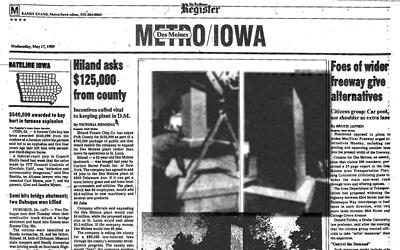
Description
This article and photograph were published on May 17, 1989, in The Des Moines Register. They focused on the newly-installed Korean War Veterans Memorial on the grounds of the Iowa Capitol.
Korean War Memorial at the Iowa State Capitol, 2017
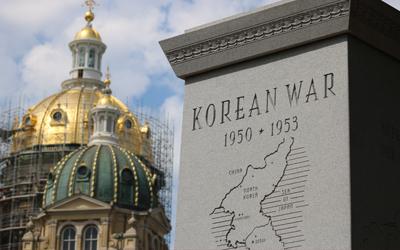
Description
Initiated by a letter to Governor Terry Branstad, students at Washington Irving Junior High School launched a campaign to fundraise for and create a memorial to Korean War Veterans on the Iowa Capitol grounds. Their goal was to raise $85,314 - $1 for each Iowan who…
Korean War Memorial Fact Sheet, 2016
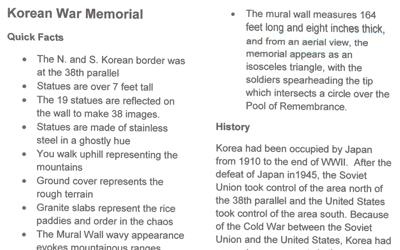
Description
This informative and concise fact sheet tells of the symbolism, history and features of the Korean War Memorial in Washington, D.C.
Excerpts from U.S. Supreme Court Ruling on Bell v. United States, 1960
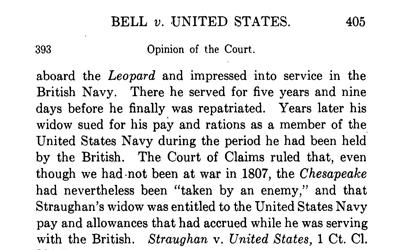
Download Resource Download Resource
Description
Bell v. United States was a lawsuit reviewed by the U.S. Supreme Court. In the case, veterans of the Korean War were suing the U.S. government for denying them pay while they were in a Prisoner of War (POW) camp in North Korea as well as after their release when they…
World Leaders Sign the United Nations Charter, June 25, 1945
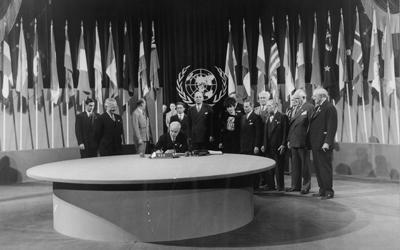
Description
At the end of World War II, several key world leaders got together to establish a new organization committed to preventing future world wars. In 1945, the United Nations was formed with 51 countries signing a…
Excerpts from the Geneva Convention: Relative to the Treatment of Prisoners of War, August 12, 1949
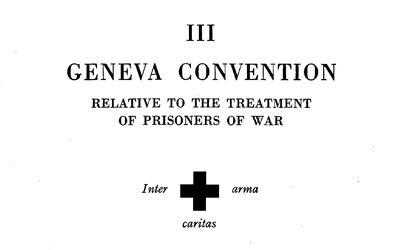
Description
Jean Pictet, the director of the Red Cross, published this commentary, including the original text, of the Geneva Convention of 1949. The 1949 convention gathered to specifically address the treatment of prisoners of war and to state where consequences would happen if that…
South Korean Soldiers Prepare and Lay an Anti-Tank Mine, July 22, 1950
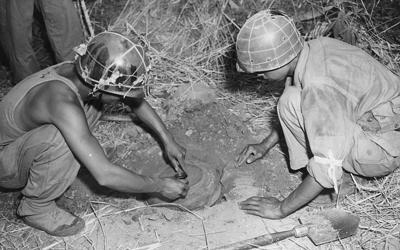
Description
Landmines have been used in warfare for decades. The United States used M15 anti-tank mines for the first time in the Korean War. It was designed to be a "track breaker," causing a tank to no longer move but likely not killing the crew inside the tank.
Unexploded land…
"Korean Pearl Harbor? Red China's Attack Threatens U.N. Victory as Mao Moves on Three Fronts" Article, November 15, 1950
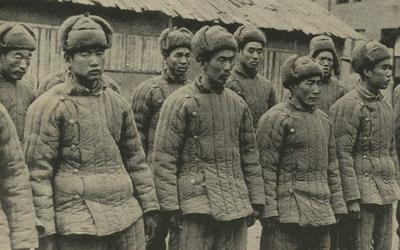
Download Resource Download Resource
Description
This article is from the 1950 Pathfinder Magazine. It discusses the surprise attack on U.S. forces, and the entry of China as a military force on the side of the North Korean Army.
American Soldier Prepares a Leaflet Bomb in Yokohama, Japan, November 1, 1950
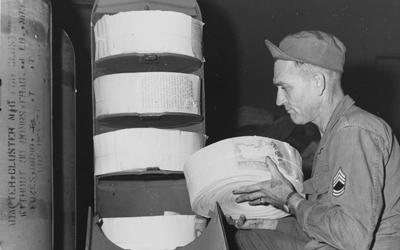
Description
An American soldier loads an M16M1 cluster adapter at the Far Eastern Command FEC Printing Plant in Yokohama, Japan. The bomb type adapter contains 22,500 psychological warfare leaflets.
Iowa Soldiers at the "Rock of the Marne" Holding the Sign "Happy New Year to the Folks at Home," 1951
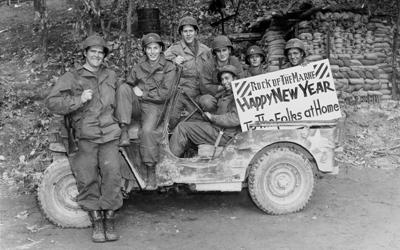
Description
Iowa soldiers serving with the 3rd Division's "Rock of the Marne," are shown in this photograph sending a New Year's greeting from Korea in 1951. The 3rd Division's "Rock of the Marne" was known as a rapid-response unit and even nicknamed the "Fire Brigade," and while their…
187th Airborne Paratroopers on a Flight to Munsan-ni, Korea, March 1951
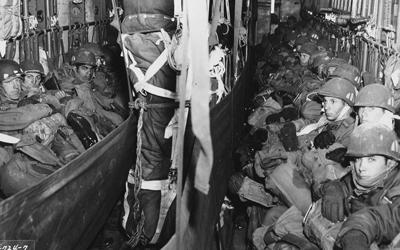
Description
Paratroopers of the 187th Airborne Regimental Combat Team are shown in this photograph seated in the cargo compartment of a 314th Troop Carrier Group C-119 on a flight to the dropzone at Munsan-ni, Korea, in March 1951. This was the second combat airborne assault for…
American Marines Capture Chinese Communists Along the Central Korean Front, March 2, 1951
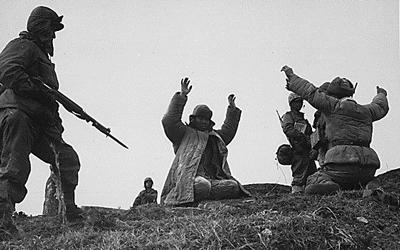
Description
Prisoners of war were taken by both sides in the Korean War. The United Nations set up several prison camps, with Goeje-do being the largest one. About 170,000 people were committed to United Nations camps, and 7,614 people died in those camps. Sixty-five percent of those…
Soldiers Seek Shelter from Mortar Shells in Korea, April 11, 1951
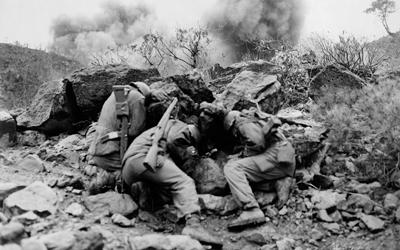
Description
Mortars were common ammunition used by both sides in the Korean War. The portable, muzzle-loading weapon was designed for high-angle fire, with a range of about 4,000 yards. These weapons could fire 40 rounds of ammunition in two minutes. In this photograph, a group of…
Marine Infantrymen Take Cover Behind a Tank Near Hongcheon, Korea, May 22, 1951
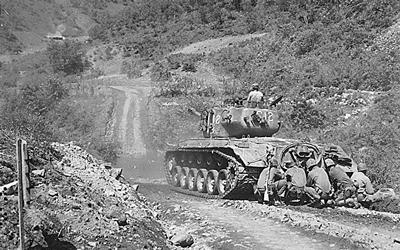
Description
Marine infantrymen in this photograph are shown taking cover behind a tank while it fires on Communist troops ahead near Hongcheon County on May 22, 1951. Five uniformed army soldiers are seen kneeling behind a tank and one man is seen coming out of the top of the tank…
Aerial View of USS Iowa Near Koje, Korea, October 17, 1952
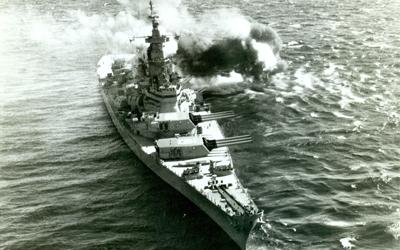
Description
This photograph shows an aerial view of the U.S.S. Iowa taken after battery gunfire aimed at Communist defenses near Koje, Korea. The USS Iowa was commissioned in 1943 and served until 1990. The Iowa sailed to the Korean peninsula in 1952, targeting North Korean supply lines…
Excerpt 1: Interview with Korean War Veteran William Donald Sinclair, April 2, 2004
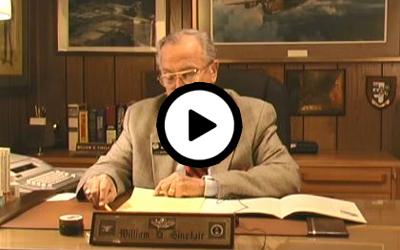
Description
After serving as a navigator in the Army Air Force in World War II, William Sinclair was contacted in 1947 about competing for a commission in the newly formed Air Force. He graduated in July 1949 from pilot training and 18 months later, he was off to serve in the…
Interview of Korean War Medics Tony and Tom Bazouska, 2015
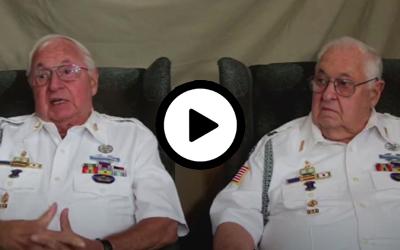
Description
This is a video clip featuring Korean War veterans Tony and Tom Bazouska, who are speaking about their role as medics in combat. The two describe how they were identified as medics in their units, and what weapons they were issued as combat medics.
American Infantrymen Grieve for a Dead Fellow Soldier near Haktong-ni, Korea, August 28, 1950

Description
This photograph captured a grief stricken American infantryman whose fellow soldier has been killed in action and he was comforted by another soldier. In the background, a corpsman was methodically filling out casualty tags in the Haktong-ni area on August 28, 1950.
Korean Woman Searches Through Rubble in Seoul, Korea, November 1, 1950
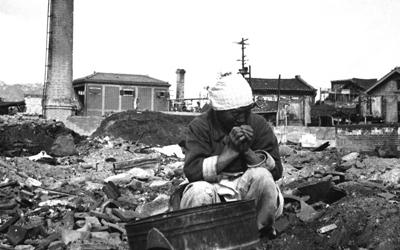
Description
This photograph shows an aged Korean woman who paused in her search for salvageable materials among the ruins of Seoul, Korea. The photo was take on November 1, 1950, by Army Captain C. W. Huff.
Memorial Service at Cemetery in Hamhŭng, Korea, December 13, 1950
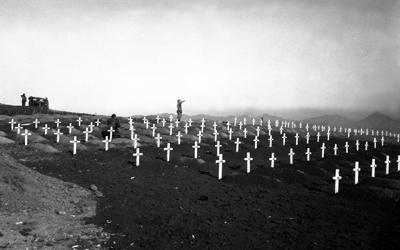
Description
Marines of the First Marine Division are shown in this photograph paying their respects to fallen comrades during memorial services at the division's cemetery at Hamhung, Korea, following the break-out from Chosin Reservoir on December 13, 1950. A total of 36,576…
Iowa Marines with a Hospital Attendant at Naval Station Great Lakes Hospital, March 1951
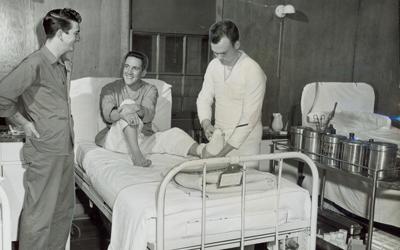
Description
Corporal Robert Tague of Fort Dodge and Sergeant John Brandenhorst of Oskaloosa posed in this photograph with hospital attendant F.E. Hodkinson of Des Moines at Naval Station Great Lakes' hospital in March 1951. Several Mobile Army Surgical Hospitals (MASH) units operated…
Red Cross Worker at MASH Hospital in Korea, October 1952

Description
This photograph shows a wounded Korean soldier in a Mobile Army Surgical Hospitals (MASH) hospital being attended by a Red Cross worker from Burlington, Iowa, Mary Jane White. White wears a uniform with a Red Cross logo on the left sleeve. She is bent down in conversation…
American and North Korean Generals Sign the Korean Armistice, July 23, 1953
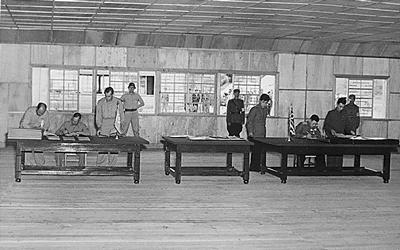
Description
General W. K. Harrison, Jr., is shown in this photograph signing armistice ending the three-year Korean conflict. Harrison is at the left table, while North Korean General Nam Il is at the right table. According to the National Archives, 158 meetings happened over a two…
Korean War Atrocities Report by U.S. Senate, January 1954
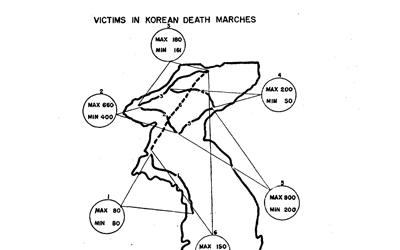
Description
U.S. Senator Joseph McCarthy appointed a special subcommittee on October 6, 1953, to investigate the war crimes committed by Communist forces in Korea with the purpose of bringing them to the world's attention. The Korean War Atrocities report…
Excerpt 2: Interview with Korean War Veteran William Donald Sinclair, April 2, 2004
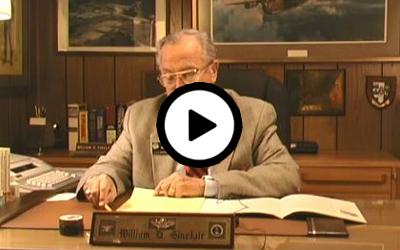
Description
After serving as a navigator in the Army Air Force in World War II, William Sinclair was contacted in 1947 about competing for a commission in the newly formed Air Force. He graduated in July 1949 from pilot training and 18 months later, he was off to serve in the…
Korean War Marine Veteran Arthur E. Gentry Recalls Evacuation of Hamheung, 2015

Description
Korean War Marine veteran Arthur Gentry recalls when he and approximately 5,000 soldiers were evacuated out of Korea near Hamhŭng (Hamheung). He remembers that about 100,000 North Korean refugees were also evacuated, and singing the Marine Corps Hymn as they marched to the…
Korean War Veterans Memorial in Washington, D.C., between 1995 and 2006
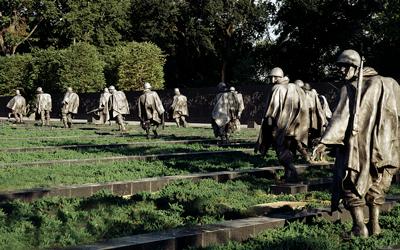
Description
Visitors to the Korean War Memorial experience a memorial rich in symbolism. Walking uphill represents mountainous terrain, and the ground cover around the statues represents the rough terrain. Among the ground cover are granite slabs that represent rice paddies. An aerial…
Additional Resources
- "Costs of Major U.S. Wars" by Stephen Daggett
This is a 2010 report by the Congressional Research Service that provides estimates of the costs of major U.S. wars from the American Revolution through current conflicts in Iraq, Afghanistan and elsewhere. - "Korean War 101" and "The Forgotten War: Iowans in Korea" from Iowa PBS
The first video from Iowa PBS is just four-and-a-half minutes long and provides a brief look at the soldiers from Iowa who served in Korea. The second is a 57-minute documentary of Korean War veterans from Iowa who share their experiences on the battlefield. - Korean Peninsula at Night
These images show area of light in South Korea and darkness in North Korea at night. - Korean War - Casualty Summary
This online document is a detailed summary of Korean War casualties, updated as of May 16, 2008. The casualties are categorized between the Army, Air Force, Marines and Navy. - Korean War Digital History Project
This online project is a developing website that houses multiple videos and tagged clips of veterans telling their experiences from the Korean War. - Korean War Legacy Project
Explore the origins and outcomes of the Korean War, the challenges that soldiers faced and its rich legacy exemplified by the democratization and rapid economic development of South Korea. - Korean War Veteran Regina H. Schiffman
This webpage from the Veterans History Project includes a small gallery of photographs of Korea War veteran Regina H. Schiffman, who served as a nurse during the war. - Remembering Vietnam: Online Exhibit
This exhibition presents both iconic and recently discovered National Archives records related to 12 critical episodes in the Vietnam War. - The Korean War
This online resource includes a brief history of the Iowa National Guard in the context of the Korean War. - "The United Nations Explained" Video
This is a useful video (2:25 minutes) that provides an overview of the United Nations for kids. - United Nations Prisoner of War (POW) Camp at Pusan
This photograph shows the United Nations' prisoner of war camp at Pusan. The camp contains both North Korean and Chinese Communist prisoners. - Virtual Tour of the Vietnam Veterans Memorial
Take a virtual tour of the Vietnam Veterans Memorial on the National Mall in Washington, D.C., to learn more about The Wall and all of the elements that make up the memorial. - 24th Infantry Division in Korea
This 28-minute video from the Korean War Legacy Foundation is a detailed look at the 24th Infantry Division as they serve in Korea. - "64 Years After Korean War, North Still Digging Up Bombs" Associated Press Article
Published by Bloomberg Politics, this article looks at how North Koreans are still finding anti-tank mines that were left in the ground, undeployed from the war. - Korea Reborn: A Grateful Nation Honors War Veterans for 60 Years of Growth by Republic of Korea's Ministry of Patriots
This is a 2017 retrospective look at the Korean War and its impact. The photos and text tell the story from the perspective of both U.S. veterans who served in the conflict, and the South Koreans who prospered from the freedom left in their wake. - Korean War Memorial by Jennifer Burrows
This is a 2010 book that tells about the creation and purpose of the Korean War Memorial in Washington, D.C. - Remembering Korea: The Korean War Veterans Memorial by Brent Ashabranner
Readers are given an in-depth tour of this national monument through profiles of important figures, an examination of its planning and creation and an overview of the history of the war that claimed 35,000 American lives in this 2001 book.
Iowa Core Social Studies Standards (9th-12th Grade)
Listed below are the Iowa Core Social Studies content anchor standards that are best reflected in this source set. The content standards applied to this set are elementary-age level and encompass the key disciplines that make up social studies for 9th through 12th-grade students.
| No. | Standard Description |
| SS-US.9-12.20. | Analyze the growth of and challenges to U.S. involvement in the world in the post-World War II era. |
| SS-US.9-12.26. | Determine multiple and complex causes and effects of historical events in American history including, but not limited to, the Civil War, World War I and II, the Korean War and the Vietnam War. |
| SS-WH.9-12.18. | Assess impact of conflict and diplomacy on international relations. |
| SS-Geo.9-12.23. | Analyze the consequences of human-made and natural catastrophes on global trade, politics, and human migration. |
| SS-Soc.9-12.14. | Identify characteristics of groups, and the influences that groups and individuals have on each other. |
| SS-Psy.9-12.14. | Examine how an individual’s involvement in a collective group can influence their individual thoughts and behaviors. |